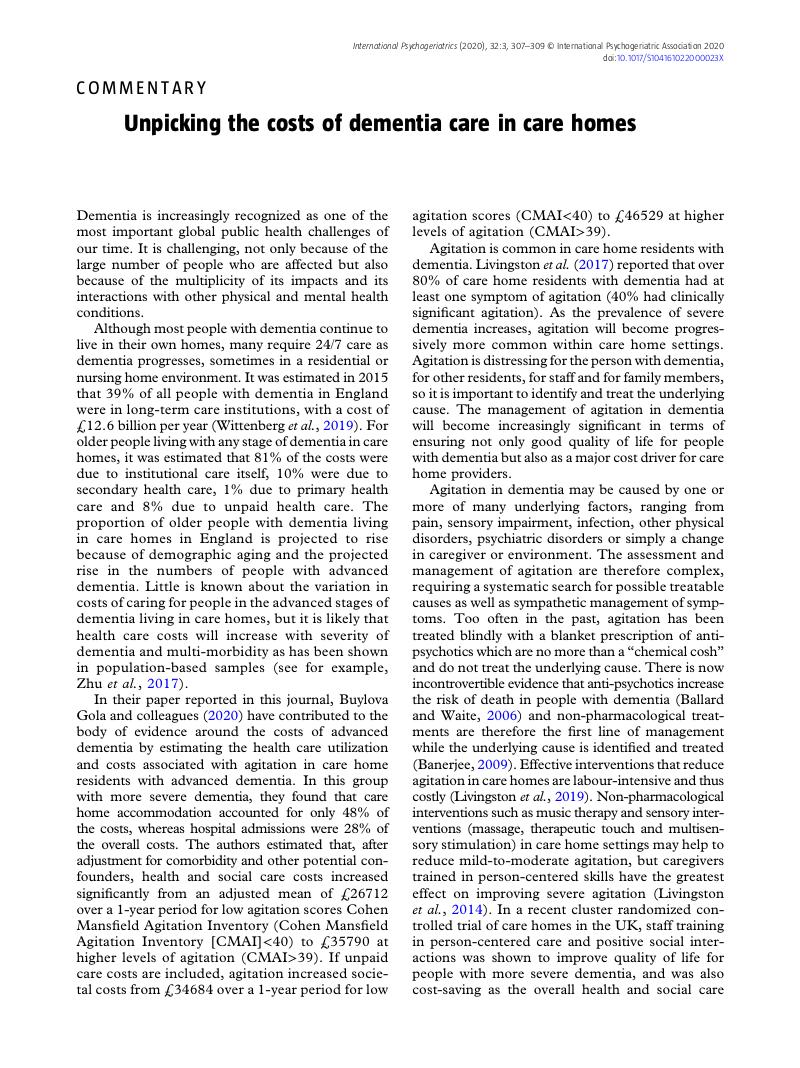No CrossRef data available.
Article contents
Unpicking the costs of dementia care in care homes
Published online by Cambridge University Press: 20 March 2020
Abstract
An abstract is not available for this content so a preview has been provided. Please use the Get access link above for information on how to access this content.

- Type
- Commentary
- Information
- International Psychogeriatrics , Volume 32 , Issue 3: Issue Theme: Improving Healthcare in Long-Term Care and Nursing Homes , March 2020 , pp. 307 - 309
- Copyright
- © International Psychogeriatric Association 2020
References
Ballard, C. and Waite, J. (2006). The effectiveness of atypical antipsychotics for the treatment of aggression and psychosis in Alzheimer’s disease. Cochrane Database of Systematic Reviews, Issue 1. Art. No.: CD003476.CrossRefGoogle ScholarPubMed
Ballard, C.et al. (2018). Impact of person-centred care training and person-centred activities on quality of life, agitation, and antipsychotic use in people with dementia living in nursing homes: A cluster-randomised controlled trial. PLoS Medicine, 15, e1002500.CrossRefGoogle ScholarPubMed
Banerjee, S. (2009). The use of antipsychotic medication for people with dementia: Time for action, London: Department of Health.Google Scholar
Buylova Gola, A.et al. (2020). Healthcare utilization and monetary costs associated with agitation in UK care home residents with advanced dementia: a prospective cohort study. International Psychogeriatrics, 32, 359–370.CrossRefGoogle ScholarPubMed
Centre for Reviews and Dissemination. (2014). Interventions to reduce unplanned admissions from care home settings. United Kingdom: The University of York.Google Scholar
Costello, H., Walsh, S., Cooper, C. and Livingston, G. (2019). A systematic review and meta-analysis of the prevalence and associations of stress and burnout among staff in long-term care facilities for people with dementia. International Psychogeriatrics, 31, 1203–1216.CrossRefGoogle ScholarPubMed
Livingston, G.et al. (2017). Prevalence of and associations with agitation in residents with dementia living in care homes: MARQUE cross-sectional study. BJPsych Open, 3, 171–178.CrossRefGoogle ScholarPubMed
Livingston, G.et al. (2019). Clinical and cost-effectiveness of the Managing Agitation and Raising Quality of Life (MARQUE) intervention for agitation in people with dementia in care homes: a single-blind, cluster-randomised controlled trial. Lancet Psychiatry, 6, 293–304.CrossRefGoogle ScholarPubMed
Livingston, G.et al. (2014). Non-pharmacological interventions for agitation in dementia: systematic review of randomised controlled trials. British Journal of Psychiatry, 205, 436–42.CrossRefGoogle ScholarPubMed
Sampson, E.L.et al. (2019). Agitation near the end of life with dementia: an ethnographic study of care. PLoS One, 14, e0224043.CrossRefGoogle ScholarPubMed
Wittenberg, R.et al. (2019). The costs of dementia in England. International Journal of Geriatric Psychiatry, 34, 1095–1103.CrossRefGoogle ScholarPubMed
Wolters, A., Santos, F., Lloyd, T., Lilburne, C. and Steventon, A. (2019). Emergency admissions to hospital from care homes: how often and what for? The Health Foundation. Available at: https://www.health.org.uk/publications/reports/emergency-admissions-to-hospital-from-care-homes.Google Scholar
Zhu, C.W., Cosentino, S., Ornstein, K.A., Gu, Y., Andrews, H. and Stern, Y. 2017. Interactive effects of dementia severity and comorbidities on medicare expenditures. Journal of Alzheimer’s Disease, 57, 305–315.CrossRefGoogle ScholarPubMed




